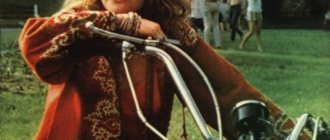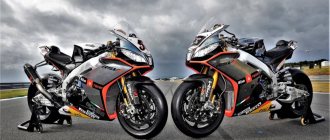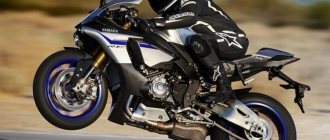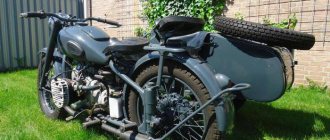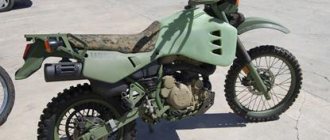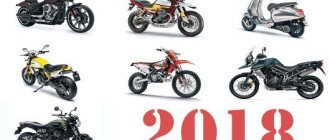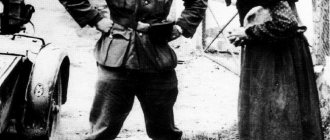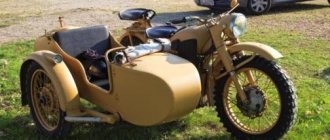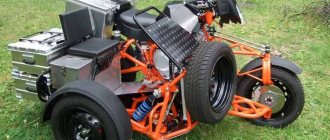Several years ago, small motor scooters became extremely popular in Moscow, making it convenient to move around the city, but now this hype is gradually subsiding, and their owners, who laid the foundation for that fashion here, are switching to iconic motorcycle models. FURFUR talked about this with Alexander Goncharenko, co-owner of the Mesto store and an experienced motorcyclist with experience.
| Motorcycles are, of course, unlike popular scooters, a completely different story. They are more difficult to operate, maintain and much more interesting in dynamics. Moreover, now everyone has grown out of motor scooters, everyone is gradually starting to get tired of it, so motorcycles, in my opinion, will finally come into fashion in the very near future. |
Moto Guzzi V7 III
The classic V7 has been in the model range of the Italian company Moto Guzzi for more than 50 years. The last major update took place last year: the 750 cc engine increased power and began to comply with Euro-4 standards, and ABS and proprietary track control began to be installed on the motorcycle by default. The V7 has an excellent chassis that allows even a novice driver to feel confident behind the wheel and enjoy cornering. Also a plus will be a large 21-liter tank and a cardan drive, which will require less frequent maintenance from you.
Tula-200. For hunters and fishermen.
The Soviet motorcycle industry did not produce ATVs (some small-scale models, however, were still produced, read below), but for the needs of hunters and fishermen, a very unusual Tula-200 motorcycle with wide off-road wheels was produced. The mass distribution of such motorcycles occurred in 1986-1988.
The engine was taken from the Tulitsa motor scooter, increasing its power to 13 hp. This made it possible to accelerate at 200k to 90 km/h. 10-12 thousand of these bikes were produced per year, the last of which rolled off the plant’s assembly line in 1996. By the way, they even produced a trike based on the Tula-200!
Motorcycle IZH-49
A middle-class road motorcycle designed for riding on roads with different surfaces. Produced by the Izhevsk Machine-Building Plant from 1951 to 1958.
After the Great Patriotic War, equipment from the DKW plant was taken out of Germany as reparations, and the Izhevsk plant received machine tools at its disposal. In 1946, under the control of the invited chief designer of DKW Hermann Weber and other engineers, DKW began production of the Izh-350 motorcycle, based on the German DKW NZ 350 motorcycle. In 1951, without stopping production, the transition to mass production of Izh-49 motorcycles was made. , which won great love among the population. In 1958, production of the Izh-49 was discontinued, since since 1955 a new model had already been produced - the Izh-56.
The motorcycle is equipped with a single-cylinder, two-stroke air-cooled engine with reciprocating loop dual-jet scavenging.
On the right side of the gas tank there is a sector of the manual gear shift lever. When changing gears with the pedal, the lever moves to the position corresponding to the engaged gear.
Technical specifications
- Overall length 2120 mm.
- Overall width 770 mm.
- Overall height 980 mm.
- Ground clearance 140 mm.
- Dry weight of the motorcycle with rear saddle is 150 kg.
- Maximum speed 90 km/h.
- Fuel tank capacity 14 l.
- Fuel consumption on the highway is no more than 4.5 liters per 100 km.
- Cylinder displacement 346 cm3
- Maximum power 11.5 l. With. at 4,000 rpm.
- Carburetor type K-28
- The gearbox is four-speed, two-way.
- The frame is stamped and welded.
- The front fork is a telescopic spring type with hydraulic shock absorbers.
- Rear suspension: spring with hydraulic shock absorbers
- Tire size 3.25-19″
M-62. Choice of police.
The Soviet police, fair and incorruptible, in the 50s-60s mostly traveled on motorcycles with sidecars.
The M-62, produced by the Irbit Motorcycle Plant, was the most popular choice of servants of the law. Its four-stroke engine produced 28 hp. An interesting fact is that ordinary citizens of the USSR were not allowed to operate Urals without a sidecar at that time. Still, these motorcycles were quite difficult to control. But the police used motorcycles without sidecars, which looked very cool in the eyes of Soviet boys. How can you not want to become a policeman!
Norton Commando 961
Norton is no less legendary British brand than Triumph. Due to the abundance of financial problems in past years, the company now has only two motorcycle platforms, but what ones! Superbikes with V4 engines and civilian models with parallel liter twins. Of the latter, you can opt for the Cafe Racer: an inverted fork and clip-ons will make its character even more sporty. But still, the models of the Commando line are products of the old school. They're not as responsive as many modern sportbikes, so if you're looking for a truly old-fashioned bike, give the Norton its due.
L-300 "Red October". The very first.
The very first serial Soviet motorcycle was the L-300 “Red October”. the first motorcycle of the USSR At the beginning of 1930, Leningrad designers prepared its drawings, inspired by the most reliable bike of that time - the German DKW Luxus 300. And already in the fall of the same year the first batch of L-300 was ready. The motorcycle was produced until 1938, and then the no less legendary IZH-8 was created on its basis. This “descendant” of the L-300 even ended up on silver coins... in New Zealand. By the way, the name IZH-7 was borne by the same L-300s, which were produced in Izhevsk in parallel with the Leningrad enterprise “Red October”.
Retro motorcycle BMW R52 /R57 1929
In 1923, the BMW R32 was released, which received a 500 cm3 engine. 3,100 copies were produced. The OHV version of the BMW R37 was announced two years later, but it was in demand and due to this, only 175 copies were produced.
In 1926, German developers presented to the world community the BMW R42 1926 model, which was released on the basis of the BMW R32 model. Improvements made it possible to design this model faster and more reliable: the engine was lighter and the braking system was improved. With a motorcycle weight of only 126 kilograms, engine power of 12 horsepower was achieved at 3400 rpm.
The BMW R52 and BMW R57 models, based on the BMW R42 and BMW R47, were announced in 1928. R52 motorcycles had a 12 hp engine. and left the assembly line for two years, while the R57 with an 18 hp engine. only just a year.
Vyatka VP-150. Italian elegance.
0
The last one in our review is not a motorcycle at all, but a scooter. The Vyatka VP-150, the prototype of which was the Italian Vespa scooter, is rightfully considered the most elegant two-wheeled vehicle in the USSR. It was a quiet and very comfortable scooter that even women could drive with ease. At the Vyatka base they made a whole range of three-wheeled scooters with various bodies, which were actively used in urban cargo transportation.
Retro motorcycles: what makes them special and attractive
In Russia, the most famous motorcycle was the Ural. Today, many models are popular not only in our country, but even abroad. Many wealthy collectors are not averse to adding this type of equipment to their garage.
In general, the history of motorcycles goes back to Germany. It was there that the first motorcycle with a gasoline carburetor engine was developed. In the USSR, such equipment began to be produced in the early 50s. In the 70s, production became widespread.
The decline occurred in the early nineties, when mass motorization began. The drop in demand has led to the emergence of new types of motorcycles.
Demand for retro motorcycles
Retro motorcycles, appearing on the streets of a modern city, will definitely create a sensation. After all, in the automotive environment, most cars look like a gray, faceless mass. That is why our retro motorcycle club “ZKS” in Yekaterinburg offers to restore your “iron horse” and return to it its lost external and technical characteristics. We have innovative equipment, painting and restoration shops at our disposal, in which all necessary work will be performed at the proper level.
In addition, we ourselves would be happy to purchase an outdated model for our collection. After all, do not forget that retro motorcycles are not just a means of transportation. This is the history of our country. After all, our great-grandfathers, grandfathers, and fathers rode them. Each motorcycle produced in Soviet times has its own history.
Restoration and restoration of obsolete brands of motorcycles - breathe new life!
Many motorcycle owners are very attached to it. That is why they, even having lost their external and performance characteristics, simply gather dust in old garages. Equipment produced in Soviet times can serve for a very long time and is easy to maintain.
Such motorcycles deserve special attention from their owners, which is why they are often restored through restoration work. However, giving “new life” to an iron horse is not very easy.
But there is a way out. You can always turn to our specialists for help, who are well versed in outdated models and will definitely revive retro motorcycles.
Collectors who are engaged in “collecting” rare models can also get our help. We can leave them in their “original” state, changing only the filling. Thus, they will not lose the great passion of the engineers of the past and will fully reflect the “spirit of the times” in which they were used.
Restored models from private collections can become real “stars” of any exhibition dedicated to retro themes.
M-72. The most combative
The M-72 was not the first army motorcycle in the USSR. In 1934, the assembly of the first Soviet heavy model PMZ-A-750 began, and in 1939 - the “understudy” of the British BSA and, considered to be the best pre-war motorcycle in the Union, TiZ-AM-600.
However, it was the M-72, the design of which was “spiked” from the German BMW R71 (the Wehrmacht was equipped with them), which came out in the tragic year of 1941, and was produced throughout the war. And then they seriously served the people for civilian purposes - the last copies rolled off the assembly line in 1960. From 1941 to 1945, the M-72 carried soldiers armed with anti-tank missile systems, machine guns or light mortars. From the first post-war years - and long after - these motorcycles became the main police transport. And since 1954, ordinary Soviet citizens could buy them for their needs. “Descendants” of the M-72 were ordered by Saddam Hussein’s Republican Guard at the beginning of the 2000s. But I didn’t have time to use it, and combat motorcycles “went to the people.” At the request of customers, Iraqi auto repair shops install additional “active and passive protection” on the Urals - armor and a machine gun.
Autoped
The American one can be considered the parent of modern scooters; it was the first to attempt to create a full-fledged scooter for moving around a big city.
The first prototype of this retro scooter was announced in 1914, and production started in 1916 after a number of improvements were made. The first scooter had a four-stroke engine in its design and had a power of 1.5 hp. The front wheel was driven through a multi-plate clutch.
Weighing only 50 kg, the price of the scooter was one hundred and ten dollars. The composition also included a lighting headlight and a signal. To make it easier to carry the scooter, it was possible to attach the folded handlebars to the rear fender.
After ending scooter production in 1920, Krupp began producing an improved scooter model in Germany in 1921.
EMW R-35.
The basis of the EMW R-35 is the BMW R-35. The post-war model R-35 was produced by the German BMW plant from 1945 to 1955. And since 1951, the abbreviation changed to EMW, and the emblem also changed, from blue to red. German engineers made several upgrades to the motorcycle. The front fork was equipped with hydraulic shock absorption, and the gear shift lever was moved under the driver’s left foot. The electrical equipment and power system changed (a new carburetor was installed), even the wheel rims and fenders changed shape. Elements have appeared on the frame that allow you to attach a side trailer. Finally, the car was rid of its main drawback: instead of a rigid suspension, a spark plug suspension was used - like on the M-72.
Motorcycle brands
| Basically, due to the fact that all this is becoming very popular now, the big brands - Yamaha, Suzuki and Honda - are introducing old models into their lines that have become fashionable. Initially, cafe racers and bobbers were custom motorcycles, that is, people made them for themselves. But this custom production has become so widespread that now everyone - from concerns like Honda to rare brands like Norton - have cafe racers in their line. There are also brands that have always been popular and have long had cafe racers among their models: Ducati, Norton and so on. | Norton Motorcycles (UK) Ltd is a British motorcycle manufacturer founded in 1898 by James Lansdowne Norton in Birmingham. |
Prices
Prices, of course, vary greatly: it all depends on the cubic capacity, year of manufacture and mileage of the motorcycle. The most popular here are the Japanese “400”, which, depending on wear and tear, can be bought for $2,500 - $5,000. But you will get tired of such a motorcycle after a year, because it is a rather boring machine. Then, depending on the volume, the price also increases. But in principle, you can buy good liter motorcycles cheaply, but you need to either do it through friends or know how to choose them. That is, you can buy a liter motorcycle for five thousand dollars, and it will run fine for another ten years.
YOU CAN BUY A LITER MOTORCYCLE FOR FIVE THOUSAND DOLLARS, AND IT WILL RIDE NORMALLY FOR ANOTHER TEN YEARS. |
BMW R35 motorcycle
The motorcycle with a single-cylinder four-stroke engine with a displacement of 350 cm3 has been produced by Bayerische Motoren Werke AG since 1937. The motorcycle has a stamped (not tubular) frame. The front fork is telescopic. The rear wheel was completely without suspension, its axle was rigidly connected to the frame, and torque was transmitted to the wheel by a shaft that worked like a torsion bar with a rubber coupling that absorbed shock loads. Gears were changed using a lever located to the right of the gas tank.
After World War II, the production of motorcycles of this model was continued by the former BMW branch in Eisenach, which ended up in the Eastern Occupation Zone and fell into the hands of the Soviet command. It became part of the Joint Stock Soviet-German Company "Avtovelo", its products were cars and motorcycles, similar in design to the pre-war models of the Bavarian brand, but received a new trade name EMW and, since 1949, an emblem with red sectors instead of the Bavarian blue ones. Therefore, the 350 cc R35 was officially delivered to the Soviet Union in the late 40s and early 50s. Late-release motorcycles were distinguished by the presence of a spark plug rear wheel suspension, which was developed by German engineers working at the Avtovelo enterprise, and foot gear shifting.
Production of the EMW R35 was discontinued in 1955, when it was finally abandoned in favor of the single-cylinder AWO-425 model of 1950, developed in the post-war GDR and belonging to the lower 250 cm3 class.
Technical specifications
- Number of seats 1-2
- Overall dimensions (single) 2180x740x1000 mm
- Wheelbase 1360 mm
- Engine Gasoline carburetor four-stroke single-cylinder overhead valve
- Working volume 342 cm3
- Power 14 hp
- Curb weight 162-177 kg
- Maximum speed 100 km/h
- Fuel consumption 3.5 l/100 km
NSU.OLS 201
NSU.OLS 201 is a motorcycle model that was produced by the German company NSU from 1934 to 1938. NSU is famous for being the largest motorcycle manufacturer in the world in 1955, and its motorcycles have set four world speed records - in 1951, 1953, 1954 and 1955. In August 1956, an NSU motorcycle driven by Wilhelm Hertz exceeded 200 mph (more than 320 km/h) for the first time.
R1955 – Japanese Harley
For the Japanese, motorcycles have always been an inexpensive and reliable means of transport. Despite all the efforts of the developers and the creation of prototypes, the bikes did not go into production, so the people of Japan were content with imports.
In 1912, Harley-Devidson bikes were brought to Japan, and at the end of the First World War, they began supplying bikes. Due to its unsatisfactory performance, the company lost the contract, and in 1924, supplies were entrusted, which subsequently led to the creation of the HD Motorcycle Sales Company of Japan."
Due to the fall of the yen in 1929, bikes imported from the States turned out to be prohibitively expensive for residents of the Land of the Rising Sun. Alfred Rich Child competently built a consortium, thanks to him Sankyo acquired the rights to fully manufacture Harley Davidson bikes. The main condition of the deal was the sale of motorcycles only on the market of the island state.
The factory was built in the capital of Japan and was the undisputed leader in the manufacture of bikes, where, in principle, the motorcycle industry was born. Harley-Davidson was exported to the island nation until 1935, when the Shinagawa plant began production at full capacity.
"Rikuo" is entirely assembled from components made in Japan. This bike is completely identical to the Harley-Davidson VL “Big Twin”, which was announced in the United States last year.
The Harley Davidson company did not announce its joint work with the Japanese, for the reason that American industrialists greatly helped the Japanese study the flow production technique before the start of World War II.
A modification of the motorcycle with a 750 cm3 engine was intended for single riders. At the end of the war, production was resumed and continued until 1950.
Harley – Davidson SA Peashooter 1928
The Harley-Devidson Peshooter was a single-cylinder bike. In 1926, there was enormous competition in the market among single-cylinder motorcycles, which included the Indian and Explesior. To successfully fight in the market, the Harley-Davidson company began producing serial motorcycles with a single-cylinder engine.
In the twenties, motorcycles with two cylinders were also sold, but single-cylinder ones were in particular demand, taking this into account, H–D began producing single-cylinder ones in 1926.
The same year, Model A and Model B were introduced, which had 350 cc engines with side valves. Model A was equipped with a magneto, but Model B added a battery and coil. A DVH version with a 50% increase in power (model AA and AB) was developed especially for racers. Motorcycles with a V-twin engine and side valves were much cheaper and were popular, but the model with an overhead valve arrangement became legendary.
The retro motorcycle model S with a DHV engine reached speeds of up to 160 kilometers per hour with an engine power of 30 hp. which was not at all bad for a single-cylinder engine with a displacement of 350 cm3. Thanks to the characteristic sound from the exhaust pipe, the model received the nickname “Peashooter”.
Where can I buy
| There are two main motorcycle markets: Japan and America, and they are very different from each other. Within the Japanese market, there are motorcycles that are very popular here - these are different four-hundred-cc versions, they are simply cheaper, but they are not made for America, they are sold only in Japan and carried only by those dealers who deal in Japanese motorcycles. All this can be bought in large offices, like Soyuz Moto, NBS Moto and so on - wherever they deal in used motorcycles. |
And the second main market is the American one, it has its own differences, its own culture. Well, there are also companies that deal with purely American motorcycles: for example, MotoTorg.
With custom motorcycles, the story is a little different: now small companies are already appearing in both Japan and America that create mini-production of custom bikes. All large companies that work with these markets can hypothetically bring their products here on order. That is, you just need to go there and say that I need such and such a specific motorcycle, and they will bring it to you, but it will most likely cost additional money, because this is not their main profile and, accordingly, an extra hassle.
Fashion
Now bobbers and cafe racers are becoming super fashionable again. This is mainly happening because the spirit of the fifties and sixties and the fashion for all that culture are returning again. Bobbers actually began when the American military returned home from World War II and realized that European motorcycles were much lighter and more maneuverable, so they began to remake their Harleys and turned them into bobbers.
Triumph Bonneville Bobber
Bobber as a class of custom motorcycles originated in the USA. Previously, these were racing motorcycles for every day: the owner came to a race on a dirt track, took part in it and returned home under his own power. In order for the road bike to be effective during the race, the wings were significantly shortened, the handlebars were low and straight, and all unnecessary elements were removed to reduce weight. The new Bonneville Bobber comes as close as possible to this image. A well-hidden rear shock absorber makes the frame's silhouette look swift, and the saddle floating above it and the rear fender adds visual lightness. The model has a classic in-line 2-cylinder engine for the British brand, which is closer in behavior to a V-twin. Peak torque is already at 4000 rpm, maximum power is 76 hp. With.
Photo: Press materials
Jawa 360. The most beautiful.
1
In the 70s, every third motorcyclist rode in Java. In total, more than 1 million Jawa motorcycles of various models were delivered to the USSR, but the 360 was the most beautiful of all. Nowadays, cherry-colored motorcycles with chrome-plated gas tanks are called “Old Lady.” Particularly valuable are specimens with a side stroller made of fiberglass. Versions were produced with a 1-cylinder engine (250/260) or with a 2-cylinder engine (350/360). By the way, Java often appeared in various films. For example, it is on the Jawa 360 that Gesha Kozodoev takes Semyon Semenovich Gorbunkov fishing on the White Rock in the film The Diamond Arm.
Motorcycle classification
Initially, motorcycles are divided into three main categories: choppers, sports bikes and classics. Sports bikes are all about plastic that adds speed; classics are, roughly speaking, the same sports bikes, but without plastic, and choppers are low, chrome-plated and screaming low-ride motorcycles. Naturally, all three types have subspecies; they all somehow intersect with each other, giving rise to a lot of hybrid variants.
| A city bike is simply a classic motorcycle, which, due to its small capacity and ease of control, is designed for riding around the city. This is more of a cycling term; it is not often used in motorcycles. |
| Bobbers are converted city and military motorcycles without everything superfluous, but now they are already made from everything. Everything that did not allow him to ride fast was removed: fenders, electrics, headlights, turn signals, an extra saddle - everything was removed, and a light motorcycle was obtained. |
| Cafe racers are a kind of ancestor of the city bike, a purely English motorcycle culture: there were guys who raced around the city on their motorcycles - along narrow streets, from restaurant to restaurant - and that’s how this name appeared. |
| Naked is another additional subtype of motorcycle, that is, a completely naked, lightweight version. They were driven to the track, and there they were sealed with plastic, turning them into sports bikes, so it’s not clear what started with what. |
| It is also worth mentioning motocross motorcycles or “cross bikes”, they are raced on dirt. |
Two-wheeled classic from the USA
You might be asked: What are the best classic US motorcycles? And without a doubt everyone will answer that this is a Harley-Davidson. This manufacturer is the largest manufacturer of heavy-duty road motorcycles in America, dating back to the company's founding in 1903. It is this company that produces the best classic motorcycles of all time. Even the famous Japanese or Honda ones cannot compare with the American classics, the dream of every motorcycle enthusiast.
Today, among many different models, this company has several that are worth mentioning:
- Harley-Davidson Breakout, a model released in 2013, combines the concept of classic and modern.
- Harley-Davidson Deluxe - the style of the 30s of the 20th century makes you feel like the king of the time and plunge into the history of the motorcycle industry of those years.
- Harley-Davidson IRON 883 - aggressive looks, unbridled power, authentic style - all this applies to this exceptional king of all American roads.
There are many more different models, both older and modern, that captivate the eye and make you fall in love at first sight.
